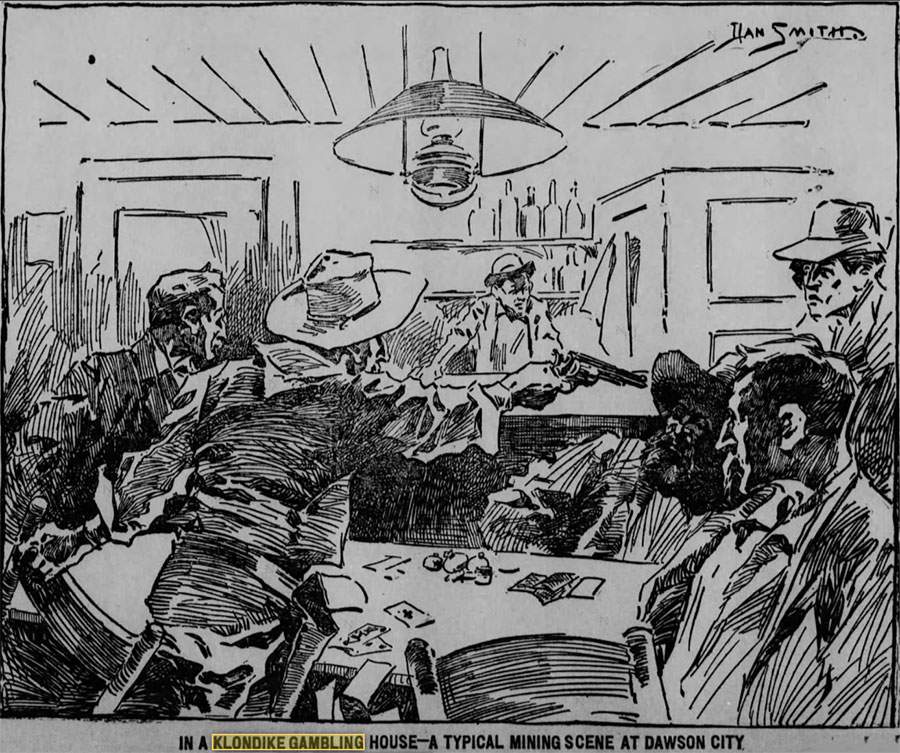Most people know Vegas Solitaire as the Solitaire to gamble on in online casinos. Many people don’t know that long before Las Vegas became the world’s gambling capital, there was already gambling with Solitaire in casinos. Better said in Gambling Houses because that’s what casinos were called in the past. Although Solitaire has never really had a significant share of the casino floor, several attempts have been made in the past to adapt Solitaire into a gambling game. In this article you can read which solitaires those were and how they were played.
Solitary
The oldest evidence that Solitaire was played as a gambling game in a gambling house is a chapter from the book “Gambling Exposed – A Full Exposition of all the various Arts, Mysteries, and Miseries of Gambling” published in 1857 by Jonathan H Green. The Solitaire described is called Solitary.
“This is a game that is played by one person. By some, it is played when they are alone, for amusement or diversion only, by others for purposes of gain.”
The game description shows it is “Old Patience,” better known today as Sir Tommy.
This form of “Patience” is considered one of the oldest forms of Solitaire from which many other solitaires are derived.
Many books and newspaper articles show that ‘Old Patience’ was the most played form of Patience until the last quarter of the nineteenth century. So it is not surprising that the gambling houses of that time tried to use “old Patience” as a lucrative game.
Whether the game has been a long-term success is questionable; Sir Tommy is one of the most challenging Solitaires to complete.
Gambling House Solitaire
The first time I found hard evidence that Canfield Solitaire was a game played in casinos was in some newspaper articles from 1902.
The article “Gambling House Solitaire is popular in Brooklyn – Correct Method of playing by a man who has frequently “bucked it.” describes the game as people played it in all the major gambling houses in New York and Chicago.
The rules of Gambling House Solitaire are more or less the same as Fascination, aka Demon or Canfield, whatever you want to call the game, but there are some key differences, the main one being that the Foundation in Gambling House Solitaire must always start with an ace. This makes Gambling House Solitaire much more challenging to complete than Canfield or Demon/Fascination, where the first base card is dealt randomly from the stock. In Gambling House Solitaire, you first have to find an Ace in either the stockpile, reserve, or the tableau, whereas in the other variants, you always start the game with one card dealt to the foundation.
The article also discusses betting and potential winnings. The buy-in was $1 per card or $52 for the deck, with a payout of $5 per card to the foundations.
If the player could complete the game in its entirety, he would receive an additional $500 or $1000 bonus, depending on which gambling house he was playing. There was a difference between the bonuses rewarded by the different casinos or gambling houses.
The fact that the casino gave a bonus shows how difficult it was to complete this Solitaire, so the “sucker” didn’t stand a chance. Perhaps partly because of this, it became Klondike Solitaire instead, which eventually grew into the most successful gambling Solitaire in history.
Klondike Solitaire
Klondike Solitaire is said to have been played in the gambling houses of Dawson City during the Gold Rush of 1896. The game dates back to when Gambling House Solitaire was a thing in New York. From many Solitaire books from 1900 onwards, the Solitaire with the triangle-shaped tableau has already been associated with gambling, primarily through references to the betting structure and possible payout.
Remarkably, in the early game rule books, Klondike is described as Canfield when people played it for real money, but the game seems to have been known as Seven Card Klondike, which is how it was described in Hoyle’s Games from 1907. From its origin, there is already confusion about the exact name. Still, nowadays, everybody will agree that when you play it as a regular Solitaire game, it’s called Klondike and when you play it for money Vegas Solitaire. (Seven Card) Klondike likely originated in the gambling houses of Dawson City.
The only objective, concrete evidence I’ve found that Klondike Solitaire was a casino game dates back to 1932. Dale Burgess’ newspaper article “Former Gambler Proves Sucker hasn’t Chance,” published in The Muncie Evening Press, describes Klondike Solitaire in detail and even explicitly mentions it together with poker as the “most popular games among gamblers.”
So Why was it not Safe?
It is striking that in two of the three articles about Solitaire in casinos or gambling houses, cheating by the casino is mentioned. The last article, in particular, pays a lot of attention to this.
“The former Gambler, who has since quit the game, proved to us that any outsider who enters a gambling house is a lamb waiting to be shorn. and when he wins, it only to inveigle larger prey into the Gambler’s pitfall.”

Jonathan Green also reported in 1857 that Solitary was being cheated. Not surprising at all. Back in time, there was no control over anything. It was a giant wild west, especially in the gambling houses or saloons. There were no casinos as we know them now. Nowadays, a casino has to protect itself against cheaters. In the past, the casino itself was hard to trust. Besides Solitaire, there was widespread fraud with roulette wheels, which would give the house even more advantage. Hence the gamblers were called “suckers” because they knew in advance that they would never come home with money.